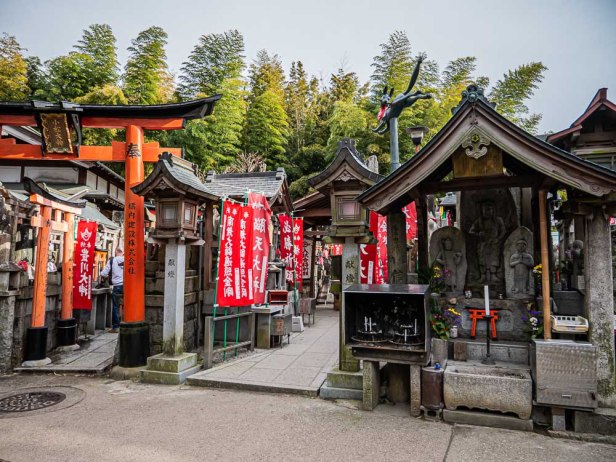
From the beginning of time we humans have worshipped mountains. They are the highest and most impressive elements of any landscape so it’s not surprising they invoke a sense of the divine. Soaring summits, unusual clouds and weather patterns that form around their peaks, the life-giving waters that flow from them, all these give mountains an aura of power and the sacred. Temples, shrines, altars, and monasteries cluster at their feet and on their slopes. From Mt Sinai in Egypt to Mt Fuji in Japan, from Emei Shan in China to Montmartre in France, from Mt Olympus in Greece to Mt Ararat in Turkey and Mt Agung in Indonesia, there are mountains the world over and in every religion that are regarded as sacred and imbued with a mystical power. One of the most significant and perhaps the least well known is Mt Kailash in Tibet. Compared to Kailash, Mt Inari in the southeastern corner of Kyoto, is merely a bump, only 233 metres (764 ft) high, but that does not make it any less revered by the people of Japan.
When I was in Japan in 2018 I walked part way up Mt Inari, famous as the location of one of the most visited places in the country, the Fushimi Inari Shrine complex. The complex consists of five shrines scattered across this wooded mountainside and I had hoped to come back another day to finish that hike but ran out of time, so when I returned to Kyoto a year later with Don I was determined to do it.
*********************
19 March 2019. We pass through the imposing romon, a two-story tower gate signifying the transition from the mundane to the sacred,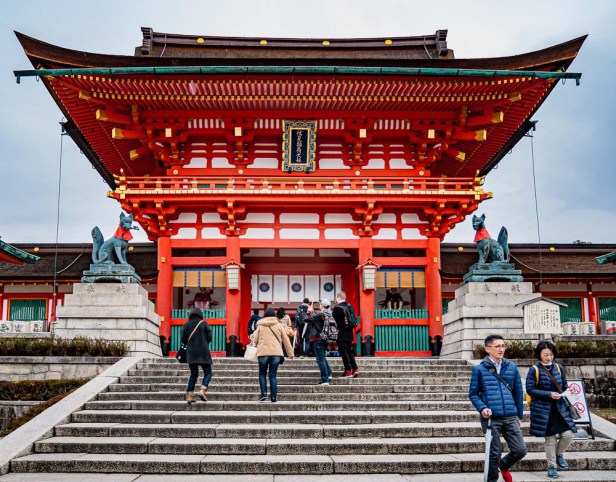
we pass the warlords that guard the entrance, in niches on either side of the romon,
we pass the worship hall that is immediately before us, and the shrine office, and this very serious fortune teller.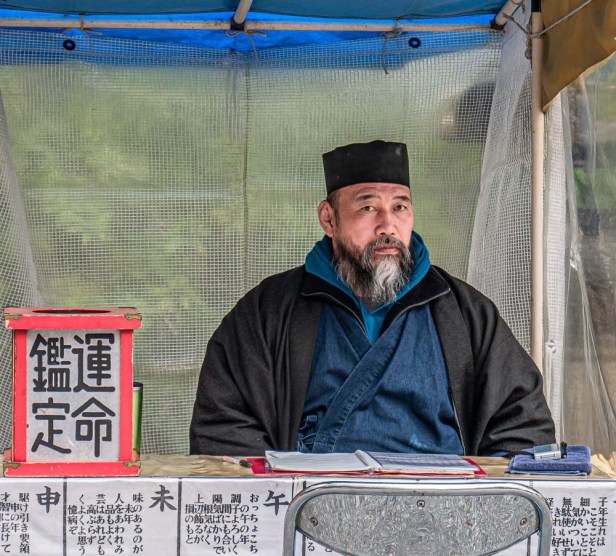
Finally we arrive at the main shrine, it’s shining red and gold beauty a beacon for the faithful.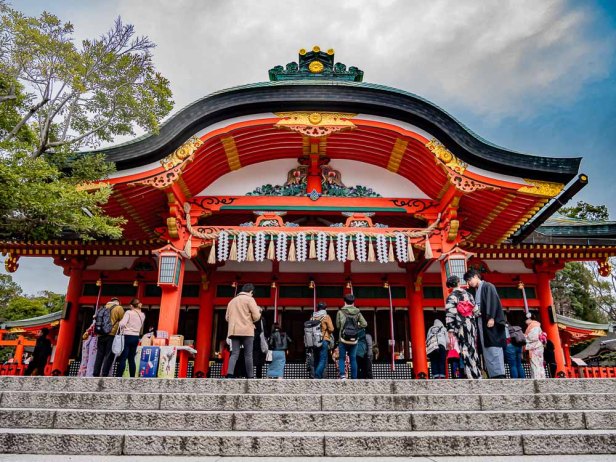
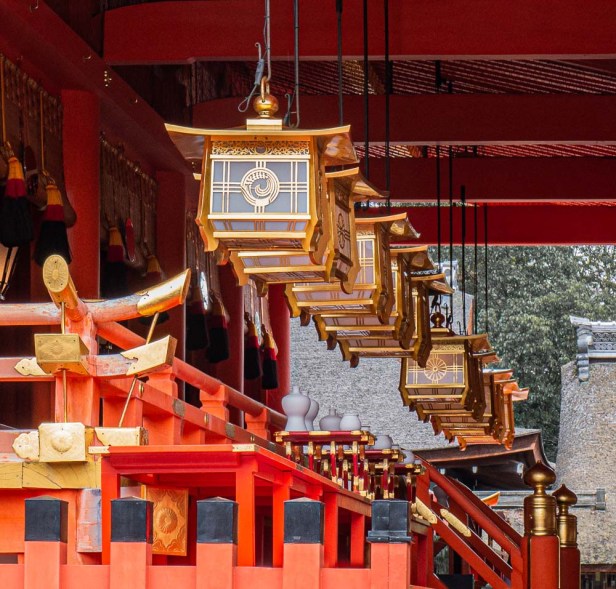
We’ve recently arrived from India where their design ethos is that more is never enough. Detail upon detail is lavished on temples, Hindu rituals and festivals, weddings, and all forms of creativity. As a result, dumbfounded by the contrast in the two cultures, I find myself bowing to the minimalism that is revered in Japan.
But it is what we come to next that is the biggest draw at Fushimi Inari. It is the side-by-side lanes of enormous brilliant red torii gates. One thousand of them. Each gate is packed so closely to the next that they form a long red tunnel.
We walk on beyond the twin tunnels following the curving path through more torii gates though they are not as densely packed. There seems to be no end to the torii gates. Each gate is a prayer or a thanksgiving, and it is estimated that there are 10,000 of them of various sizes on the mountain.
Eventually we come to the crossroads. It’s the red dot on the map.
It is here that we turn right and head up the hill. Actually I should say we head further up the hill as we’ve been gently climbing the whole time.
Eventually we find ourselves on a beautifully wooded trail.
For all that we’ve been walking for quite a while this feels like the beginning. Now we have left the crowds behind. Soon we come to a bamboo forest and stop to explore.
I’d been to the famous (and crowded) bamboo forest at Arashiyama and was disappointed that it was fenced off. Here I have the chance to actually get inside a bamboo forest, to hear the singing of the leaves high overhead, to see the trunks gently swaying. A natural bamboo forest is a remarkable and beautiful thing.
Passing one of the fiercely guarded lower shrines
we continue on a narrow path now laid with stone steps and leading past greenery to more bamboo side by side with a shattered pine forest. The previous September there had been a typhoon, the worst in 25 years, and the trees have fallen like matchsticks. We see this devastation all over the upper reaches of Mt Inari.
Walking on we arrive at one of the many subshrines, or places of worship, that are scattered all over the mountain. We dive into it. It is a complex rabbit warren, a mini village of worship stacked haphazardly on the side of the hill, every last tiny space utilised. There are diminutive altars, stone lanterns, and stone gods; all dominated by the bright vermillion of dozens of torii gates.
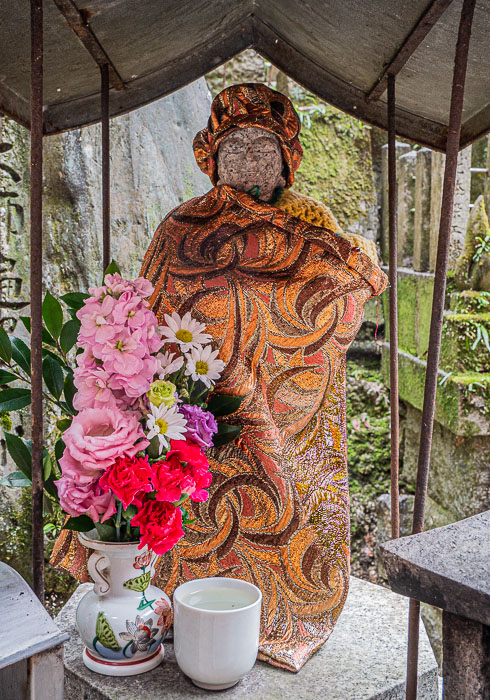
And foxes.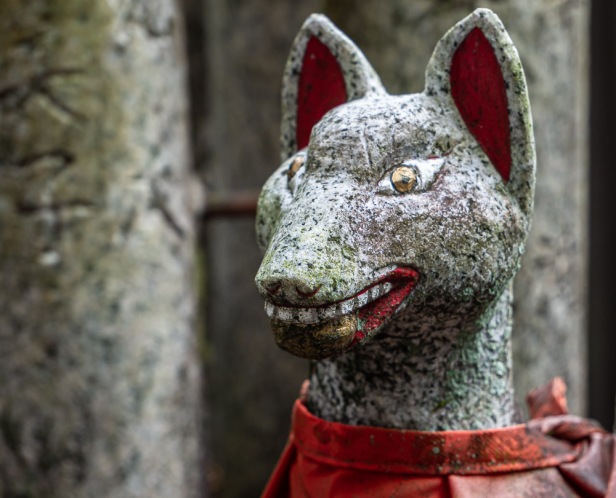

Everywhere we go there are foxes. Inari, the kami, or Shinto god of rice is believed to communicate with humans using foxes. They are Inari’s messengers from the spirit world. As for Inari, this is a fable born of a universal worship of nature. Every ancient culture created myths in an attempt to understand and appease the natural world. This is the story of how ine, meaning rice seedling, became the god Inari, which means becoming rice.
Some 1400 years ago Hata no Irogu had amassed rice and possessed overflowing wealth. He had so much that he made archery targets from pounded rice. One day when an arrow pierced the target it transformed itself into a white bird. Irogu followed the bird, which flew up and alighted atop what is now Mt Inari. There it transformed again, this time into living rice seedlings. Irogu was so moved by this wonder that he erected a shrine and worshipped the transformed rice plants. Thus was the beginning of the worship of Inari as a god, and thus was Inari given as the name of the shrine dedicated to this god. The Inari Shrine is the very beginning of the worship of the deities of crops.
Continuing on we’re again surrounded by bamboo forest. Looking up I see in each luxurious green frond the perfect feather for a Cavalier’s hat.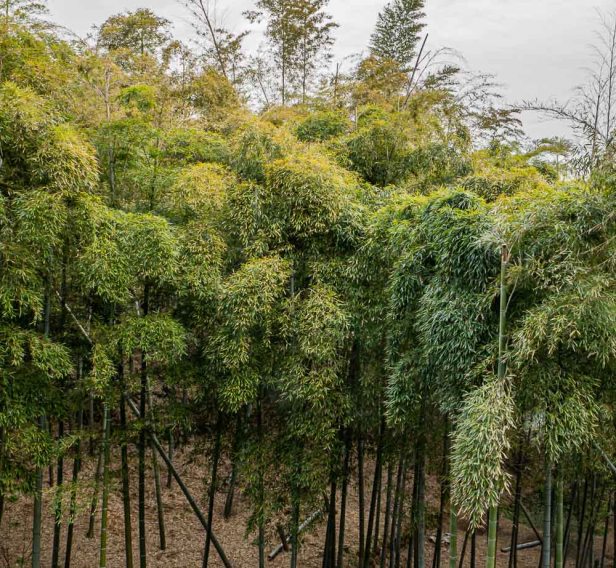
Beyond the bamboo we pass under a large grey stone torii and find ourselves once again surrounded by pine forest shattered by the typhoon.
Now we’re climbing on the roughhewn steps of a narrow path surrounded by ferns and lush greenery.
Passing under two large torii, their brilliance faded by time,
we arrive at last at the summit, and Kami-no-Yashiro Shrine.
We are descending now.
Five times during this hike we pass through a tunnel of torii gates packed closely side by side.

Soon we arrive at another area of worship where altars are crammed in together and piled one atop the other, the red of the torii gates, banners and “clothing” a stark contrast against the grey stone. It is another rabbit warren of worship.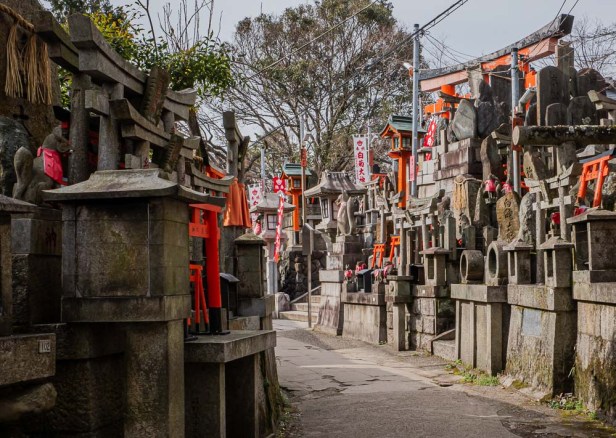

And here there are views! Southern Kyoto is spread out before us.
We continue on the meandering path down the mountain, through forest,
past another shrine,
past another village of altars, the fourth on the mountain, and a Japanese couple dressed for their pilgrimage to Fushimi Inari.
We come to an incongruous Taoist shrine, and the equally incongruous Quan Yin, an ancient East Asian goddess that was incorporated into Buddhism. I have read a scathing indictment of Shinto as this: Shinto priests do not know anything about religion, they know just business. Perhaps a Taoist shrine and Quan Yin are good for business, not that the source of the quote is necessarily an expert in the field.

And now we are on the pathway back down to the main shrine, passing a store selling religious paraphernalia.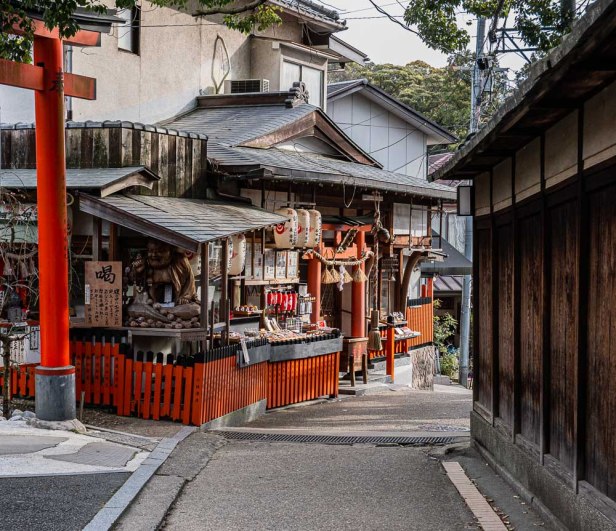
I do not know if this magnificent creature is for sale or if it’s a guardian of the store.
I go through so many feelings on this day. Because, when I first visited in 2018, the beginning of the hike was such a surprise, and so rural, I was expecting more of that, and am disappointed when most of the hike turns out to be more or less on-going places of worship interspersed with short interludes of a more natural setting. But then the places of worship are so astounding that I’m completely gobsmacked by them; gobsmacked by the sheer abundance of statues and images. I’m not referring so much to the obvious shrines (there are five of them on the mountain including Kami-no-Yashiro Shrine at the summit), but the rabbit warrens; the places that are crammed villages of altars, and statues of gods, and flying banners, and cloth bibs tied on stone deities, and tiny toriis, all overflowing and tumbled in together. It is all evidence, all a testament to the hundreds of thousands of devotees over hundreds of years. And of course every time we come to another tunnel of toriis I revel once again in their radiant beauty.
In the end I’m left, finally, with an understanding of the cult of Inari, for indeed it is a cult, not in the modern usage of the word, but in the same way that in ancient times worship of Aphrodite was a cult, an inherent part of the culture. This place, this mountain is Ground Zero, is the very birthplace of the worship in Japan of crops as deities. It all began here. There are now more than 30,000 Inari shrines throughout the country, and thousands come on a pilgrimage here to worship, to pray to, to revere the god of rice, and by extension the god of sake, and the god of prosperity and good fortune.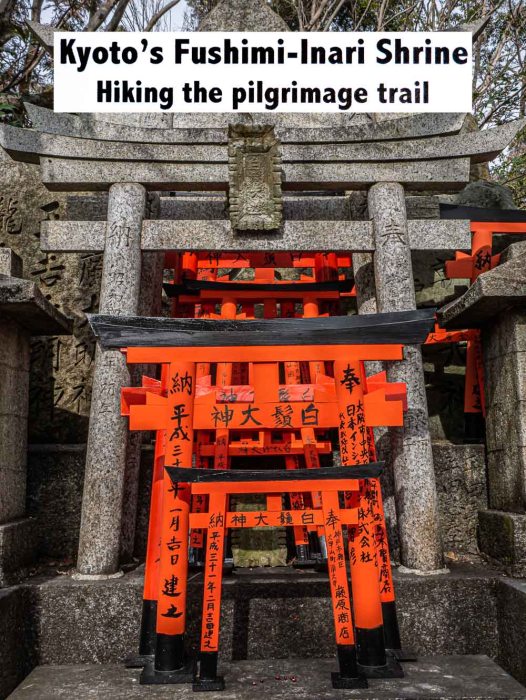
All words and images by Alison Louise Armstrong unless otherwise noted
© Alison Louise Armstrong and Adventures in Wonderland – a pilgrimage of the heart, 2010-2020.

Wow! What a rich history there! It’s interesting you should do a post about mountain climates. I just found out from one of my blog readers about the Banff Centre Mountain Film Festival that’s online and there are a lot of documentaries to watch that are set in mountain areas. If you’re interested, you should look it up!
LikeLiked by 1 person
Oh Japan is amazing. I find their history and mythology so fascinating. I’ll check out the Mountain Film Fest. I’ve heard of it of course, but never looked into it.
Alison
LikeLiked by 1 person
I remember that long red tunnel…so joyful to see the colours Alison…and to revisit 🤓❣️ hoping your well ~ hugs 🤗
LikeLiked by 1 person
Thanks Hedy. Fushimi Inari is such an amazing place. Glad I went back. Hugs to you too.
Alison
LikeLike
Hi, Alison: Very informative and evocative; as all your writing is. Thank you. I’d like to ask some questions about logistics: How long does it take to walk to the top of the mountain and see all the shrines and walk through all the torii gates? Would this occupy a full day? a half day? what else is there to see in that area of Kyoto, so as to plan a full day itinerary?
LikeLiked by 1 person
Thanks so much Charlie. I think the walk took about 3-4 hours. It’s actually a pretty easy hike, and only 4 km, but there’s much to see so we stopped a lot. Also there’s the time it takes to get there and back again to your accommodation. We walked a total of 9.5 km that day. I really strongly advise starting early. Arrive no later than 8am, even earlier would be better, and from arrival time allow about 4 hours to really see the whole thing, stop for photos, etc. There’s a lane of fabulous street food between Fushimi Inari Station and the shrine entrance. Also a couple of cafes on the hike itself.
There is so much to see in Kyoto I hardly know where to start, but if you start early and want one other thing to see in the afternoon I’d recommend the Golden Pavilion. It will mean some travel time between the two places but at the Golden Pavilion it’s easy to get a good view of it even if there are crowds, and there’s a nice teahouse at the end of a short walk through the pavilion grounds.
Other options on the same train line (for easy travelling using local transport) can be found here:
https://www.kyotostation.com/the-keihan-main-line-keihan-electric-railway/
Although it’s a 25 minute walk from Kiyomizu Station Kiyomizudera Temple is worth a visit.
Hope this helps
Alison
LikeLike
I would love to return to Japan and Kyoto. We did not do this when we were there now 15 years ago! Someday we will be back. Saving.
LikeLiked by 1 person
Kyoto is so amazing isn’t it! I hope you get back. This place is definitely worth a visit.
Alison
LikeLike
Lovely place. Certainly seems to engender thought/meditation. Ta.
Keith
LikeLiked by 1 person
Thanks Keith, my pleasure. Glad you enjoyed it. It’s a pretty amazing place.
Alison
LikeLike
There is certainly a real solemnity in the layout of the temples, but what struck me most in your article is the bamboo forest. We are so used to rigid trees, that seeing the flexibility of bamboo is a change. This flexibility seems to have preserved them from the consequences of the typhoon.
LikeLiked by 1 person
The bamboo forest was wonderful, so different from a normal forest. And yes, it was not nearly as severely damaged as the pine forest. I think bamboo is a metaphor for life.
Alison
LikeLiked by 1 person
Gorgeous! I love the torii gates.
LikeLiked by 1 person
Thanks Cindy. I love the torii gates too.
Alison
LikeLike
Beautiful, both the photos and your writing.
LikeLiked by 1 person
Thank you so much Kay. So lovely to see you on zoom last week.
Alison xox
LikeLike
I remember waiting quite a long time to get some ‘clear’ shots of the vermillion torii, although in retrospect I think it would’ve been quite interesting to see some people in the photos as well, just like what you show here in this post. It’s interesting when you compare the aesthetics of temples in India with those in Japan — the differences can pretty much provide us with a glimpse of what’s important for each culture and how this translates to people’s everyday life.
LikeLiked by 1 person
Oh I remember writing how bent out of shape I got trying to get there early enough to get *the* shot, the one with no people, so I understand what you mean. There is something so beautiful about the torriis with no people in the shot, but then again having people gives a different perspective.
I’m both fascinated and completely perplexed by the difference in the Indian and Japanese cultures and aesthetic. The world is a fascinating place!
Alison
LikeLiked by 1 person
Ah, Alison, this was the perfect blog post to enjoy on a rainy Sunday morning. Thank you for taking us along on a mindful stroll up (and back down) Mount Inari. Your appreciation for the details and the organic, layered appeal of the various subshrines go so well with your musings on Shintoism and religious belief. The sight of the flattened pine trees is certainly humbling. My family members back in Hong Kong are no stranger to the destructive power of typhoons – as a teenager, I sometimes wished for them because we’d get the day off school if they were strong enough!
LikeLiked by 1 person
Thank you so much James. My pleasure. I’m glad you enjoyed it. I find places like this so interesting because they are so far outside my experience and view of life. And I love the myths – they’re so creative.
As for typhoons I remember living in Australia’s far northwest in an iron ore mining town and cyclones would form off the coast. If it looked like it was going to make landfall anywhere close the entire town would shut down. Like you I hoped so because everyone would get a day off work.
Alison
LikeLiked by 1 person
Such an informative post! We’ve yet to visit Japan and when we do, I’d love to visit Fushimi Inari. I had seen the photographs of the red torii gates but had not known that each symbolized a prayer and that there were actually 10,000 of these gates making the tunnel.
LikeLiked by 1 person
Thanks so much Aditi. I hope you get to Japan one day. It’s an amazing country.
About the toriis – there are 10,000 spread all over the mountain (including all the little ones I think), and then the twin tunnels, which are the most famous ones, are made up of about 1000 gates. Either way it’s a lot! And definitely worth a visit.
Alison
LikeLike
Those long passageways seem like gateways to a deeper state of meditation. Maybe that’s the point? Those that are faded by time may be less vibrant, but to me they give the place a more venerable atmosphere. Like an elder.🙂 How I enjoyed this tranquil virtual stroll. Thank you, Alison.
LikeLiked by 1 person
Thank you so much Julie, my pleasure. The long passageways are so unique, and powerful. I don’t know if they were deliberately set up that way, or just grew organically. I suspect organically because each torii was donated by a different business, and maybe they all wanted to be as close to the main shrine as possible. Either way something hypnotic has evolved, especially if you can get there before/or after the crowds. I’ve read reports of people who visited after dark when they had the place to themselves – they talk of the serenity, and the silence.
Alison
LikeLiked by 1 person
The structures are obviously beautiful and impressive (I have always loved the look of the torii), but what I love seeing most is the bamboo. (I especially love seeing it on a 13″ screen and not in my own yard, where it requires daily work – ugh.) It is such a simple tree, but I’ve always been attracted to its lean look, flexibility, and appearance in great forest spreads. Great shot of Don in there, too!
LikeLiked by 1 person
I so agree about the bamboo – fabulous in its natural state, a complete PITA in an urban garden. I remember seeing bamboo in China that had such huge fronds on top that at first I didn’t recognize it as bamboo. Wish I could have walked around in that forest! Thanks re the pic of Don.
Alison
LikeLiked by 1 person
I love reading this post. Lovely words and beautiful photographs. You instilled in me a severe dose of wanderlust.
LikeLiked by 1 person
Thank you so much Chirasree. I’m glad you enjoyed it. I too am itching to travel again. One day . . . . .
Alison
LikeLike
I can see why you would want to do this 4 km hike. The views of nature and culture along the way were great. And then those views from the top. Definitely worth getting up early for.
LikeLiked by 1 person
It was not a particularly strenuous hike at all, but was so worth it. Most of it was quite unexpected, and really interesting. In the end, getting there and back home again we walked 9.5 km. A good day that’s for sure.
Alison
LikeLike
I can see why you were determined to go back. Those tunnels of torri are unlike anything I’ve ever seen – and are so intriguing! Tunnels of all kinds that are in the open like that (not leading underground) have always fascinated me.
I can understand being disappointed by the limited exposure to the natural bits – those were my very favorite part of the pictures. I’ve never walked in a bamboo forest, just alongside a small copse or two.
What a change from India!
LikeLiked by 1 person
It was a massive change from India! I love both countries and they couldn’t be more different.
The torii tunnels are really beautiful. It doesn’t show in these pics, but the twin tunnels closer to the main shrine have a curve in them so you don’t see the end when you go in. You kind of get lost in this red wonderland. Check out the post The Red and the Gold suggested at the end of this post and you’ll see what I mean.
The bamboo forest was just lovely!
Alison
LikeLike
Fantastic photos, Alison. Having experienced this just a couple of years ago, your photos brought back the excitement we felt seeing these places. How cool that you walked in a bamboo forest. Was that near the gates?
LikeLiked by 1 person
Thank you so much Jane. It’s a pretty spectacular place isn’t it! Although I’d seen pictures, the first time I saw those torii tunnels I was blown away. Glad it brought back some good memories for you. The bamboo forest was quite a way up the hill behind the shrine past the toriis.
Alison
LikeLike
I wondered if it was on the hike up from the gates. We didn’t venture up there.
LikeLiked by 1 person
I’ve come back to this post 3 times to try and leave a comment, Alison. In the end I’m not sure what I want to say. My stepbrother died unexpectedly yesterday and my day disintegrated. We weren’t close but he’s much younger than I and it was a shock. Thank you for taking me to beautiful Japan. 🙂 🙂
LikeLiked by 1 person
Oh Jo I’m so sorry for your loss. You must be quite shocked. It is all so fragile isn’t it.
I’m glad you enjoyed this little trip to Japan, even if it was only a brief respite. And thank you so much for commenting under such unsettling circumstances.
Hugs
Alison
LikeLiked by 1 person
Fabulous post Alison.I’ve earmarked this place as one to visit if and when I make it to Japan one of these years. Had to chuckle at the word “minimalism” in the context of 1000 gates… and a rabbit warren of shrines… but yeah, I know what you mean having come from India 🙂 Another chuckle at “the god of sake” by extension…
Surati
LikeLiked by 1 person
Thanks so much Surati. If you ever get to Japan I’d definitely put Fushimi Inari Shrine on the must see list. Get there early as it gets very crowded (in normal times lol). The shrine and the torii tunnels are amazing, and the hike to the top of the hill a sweet bonus. I’m so glad we did it.
Yeah those rabbit warrens of altars etc are definitely not minimal. Nor the toriis!
Everyone knows sake needs a god, if only to give thanks to 🙂
I think I’ll add a bit about it being the god of prosperity – because way back wealth and prosperity was measured by how much rice you had.
Alison
LikeLiked by 1 person
Prosperity indicator… and how much sake you could make and drink 🙂 LOL I did get the piece about prosperity, it’s there. And I can imagine the crowds – same here. I try to travel and visit sights on weekdays as it gets really busy other times. I heard Japan is thinking of opening up for tourism… the Olympics are coming up and I’m curious how this will be handled… xo
LikeLiked by 1 person
They seem really determined to have their Olympics. Knowing the Japanese they’ll do what they need to to keep people safe but it strikes me as a huge logistical nightmare – just the Covid part let alone all the rest of it which is a given.
LikeLiked by 1 person
I am enthralled by the photos of the bamboo forest. that photo stirred up wanderlust I have not felt all year. I’ve never seen anything like it and now hope one day very much to go.
LikeLiked by 1 person
Sorry for stirring up wanderlust, but I do hope you get to wander in a bamboo forest one day. It’s quite magical. Japan or China, but I imagine there are also other places in SE Asia that have bamboo forests.
So much world so little time . . . . .
Alison xo
LikeLiked by 1 person
Thank you for sharing the upper reaches of this magnificent place! We stopped about halfway on the loop and returned to the bottom. I wish we had kept going. The bamboo forest is beautiful — such a wondrous material. Love seeing all the foxes, too! They add character at every turn. Loved this escape to Japan! Thanks Alison.
LikeLiked by 1 person
Thanks Kelly. You’re welcome. It was a really good day and I’m so glad I went back to complete the loop. It’s a great example of being able to explore further when you’re able to return to a place. But yeah – so much world, so little time.
Alison
LikeLiked by 1 person
Alison we were right here on the same hike exactly this time last year and yet it seems like yesterday it is so fresh in my mind. thanks for the good memories.
A few things in your post caught my attention. First of all I appreciate the pointing out of divinity associated with mountains the world over and the juxtaposition of places I would not have thought of juxtaposing such as Montmarte in Paris and Mt. Agung in Indonesia but yes you make a good point!
We smiled at the comment about arriving in Japan after India and it was remindful to us that context counts so much … when you traveling we have discovered that WHERE you come from can impact one’s experience. For example, we arrived in Istanbul directly from Rajiasthan and in comparison Istanbul seemed positively bleak and devoid of color! Any other time, coming from the U.S. or Europe, Istanbul’s Eastern charms and magnificent mosques would have been the dominant impression. Then again it was also winter which added to the dreariness. But from India to Japan we can see how the simplicity of Japanese design would really stand out!
Your second photo of bamboo looks like it might be black bamboo which is a particularly lovely Japanese species and is fairly rare and not found in many countries.
Lovely post! Wonderful photographs.
Peta
LikeLiked by 1 person
Thanks so much Peta. I can’t remember now what got me thinking about sacred mountains – it feels like one of those bits of inspiration that come from no where from time to time. Once the idea arose I started thinking about all the sacred mountains I’ve visited. And it was pretty obvious that Inari is sacred to the Japanese, and research told me how much.
We loved Istanbul, but yes, I can imagine it looked a little plain after Rajasthan. Well almost anywhere looks a bit plain after India, and the culture shock from India to Japan was huge.
I was so pleased to be able to actually get inside a bamboo forest – it’s so unique. And beautiful. I’d remembered it from my first visit so was on the lookout for it.
Alison
LikeLike
There are so many visual treats here, I really can’t begin to single anything out. (But oh, the serious fortune teller, the bamboo groves, the tori!) There is a wonderful overall color pattern here – the interesting red-oranges, weathered just the right amount, with neutrals and then all the lush greens. What a great hike! Thank you for sharing it.
LikeLiked by 1 person
Thank you so much Lynn, my pleasure. This whole place is such a visual feast (there’s a previous post about my earlier visit that focuses more on the main shrine).
I think I took more people pics, but the fortune teller (at least that’s what I think he is) just had to be included. And yes the colour palette – so lovely – all that red, green, and stone grey. And the bamboo was a special treat. It was a wonderful hike.
Alison
LikeLiked by 1 person
What a wonderful culture rich post
Love the description of the bamboo forest as offering “the singing of the leaves high overhead”
And swaying and other things
Also the tunnels of the gates must have been cool to walk through
LikeLiked by 2 people
Thank you so much. The bamboo forest was lovely and so unique. And those torii tunnels are really quite wonderful; a very special experience to walk through them.
Alison
LikeLiked by 2 people
Hi Allison – thanks for the reply and happy new year to you and Don
LikeLiked by 2 people
Happy New Year to you too!
Alison
LikeLiked by 2 people
Beautiful journey!
LikeLiked by 2 people
Thank you so much. It was a wonderful day.
Alison
LikeLiked by 2 people
This looks like such a beautiful hike & definitely makes me want to return to Japan. And when I do & visit Kyoto, I would love to follow in your footsteps as this looks & sounds stunning.
LikeLiked by 2 people
It was a fabulous day Sue, and really worth doing. Millions go to Fushimi Inari, but few venture beyond the torii gates at the bottom around the main shrine. It was so lovely to explore the whole mountain.
I don’t know if you’ve been or not, but Kyoto is amazing and should definitely be high on your list if you get back to Japan.
Alison
LikeLiked by 1 person
What an amazing trip Allison and Don. I love the architecture.
Ryan
LikeLiked by 1 person
Thank you so much Ryan, it *was* an amazing trip. I too love the architecture. And I totally fell in love with Japan. It’s a wonderful country.
Alison
LikeLike